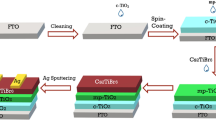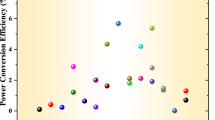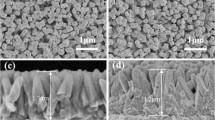Abstract
In our recent study, we delved into the exploration of solution-processed copper antimony sulfide (CuSbS2, referred to as CAS) nanostructured materials.Upon verifying its purity, we employed this nanostructured material as a key constituent in the production of thin films via the electron beam evaporation method. We comprehensively analyzed the characteristics of a thin film made from CAS. To thoroughly examine its properties, we employed a variety of analytical techniques, including X-ray diffraction, Raman spectroscopy, Field emission scanning electron microscopy, Energy dispersive spectroscopy, X-ray photoelectron spectroscopy and UV–Visible spectroscopy. To assess the influence of architectural adjustments on the efficiency of solar cells, we conducted modifications by substituting the standard intrinsic-zinc oxide (i–ZnO) window layer with a one-dimensional (1D) n-type TiO2/Sr-doped TiO2 and integrating an active layer composed of CAS. Notably, the solar cell utilizing Sr-doped TiO2 nanorod thin films achieved a power conversion of 1.4% under simulated solar light irradiation at 1000 Wm−2. This efficiency stands out significantly when contrasted to solar cells based on undoped TiO2. The increase in conversion efficiency observed in the Sr-doped TiO2 nanorod thin films is primarily attributed to two key factors: the rapid transport of electrons within the TiO2 nanorod thin films and the positive shift of the flat band potentials.








Similar content being viewed by others
Data availability
The datasets generated during and/or analyzed during the current study are available from the corresponding author upon reasonable request.
References
A.V. Shah, R. Platz, H. Keppner, Thin-film silicon solar cells: a review and selected trends. Sol. Energy Mater. Sol. Cells 38, 501–520 (1995). https://doi.org/10.1016/0927-0248(94)00241-X
L.E. Bell, Cooling, heating, generating power, and recovering waste heat with thermoelectric systems. Science (2008). https://doi.org/10.1126/SCIENCE.1158899
D.A.R. Barkhouse, O. Gunawan, T. Gokmen, T.K. Todorov, D.B. Mitzi, Device characteristics of a 10.1% hydrazine-processed Cu2ZnSn(Se, S)4 solar cell. Prog. Photovolt. Res. Appl. 20, 6–11 (2012). https://doi.org/10.1002/pip.1160
R.W. Miles, G. Zoppi, I. Forbes, Inorganic photovoltaic cells. Mater. Today 10, 20–27 (2007). https://doi.org/10.1016/S1369-7021(07)70275-4
M.A. Green, Y. Hishikawa, E.D. Dunlop, D.H. Levi, J. Hohl-Ebinger, A.W.Y. Ho-Baillie, Solar cell efficiency tables (version 51). Prog. Photovolt. Res. Appl. 26, 3–12 (2018). https://doi.org/10.1002/PIP.2978
P. Jackson, D. Hariskos, R. Wuerz, O. Kiowski, A. Bauer, T.M. Friedlmeier, M. Powalla, Properties of Cu(In, Ga)Se2 solar cells with new record efficiencies up to 21.7%. Phys. Status Solidi Rapid Res. Lett. (2015). https://doi.org/10.1002/PSSR.201409520
M. Nakamura, K. Yamaguchi, Y. Kimoto, Y. Yasaki, T. Kato, H. Sugimoto, Cd-Free Cu(In, Ga)(Se, S)2 thin-film solar cell with record efficiency of 23.35%. IEEE J. Photovolt. 9, 1863–1867 (2019). https://doi.org/10.1109/JPHOTOV.2019.2937218
M.A. Green, E.D. Dunlop, J. Hohl-Ebinger, M. Yoshita, N. Kopidakis, A.W.Y. Ho-Baillie, Solar cell efficiency tables (Version 55). Prog. Photovolt. Res. Appl. 28, 3–15 (2020). https://doi.org/10.1002/PIP.3228
W. Shockley, H.J. Queisser, Detailed balance limit of efficiency of p–n junction solar cells. J. Appl. Phys. 32, 510–519 (1961)
Yu. Li**, R.S. Kokenyesi, D.A. Keszler, A. Zunger, Inverse design of high absorption thin-film photovoltaic materials. Adv. Energy Mater. 3, 43–48 (2012)
T. Guo, D. Wang, Y. Yang, X. **ong, K. Li, G. Zeng, B. Li, M. Ghali, Preparation and characterization of CuSbSe2 thin films deposited by pulsed laser deposition. Mater. Sci. Semicond. Process. 127, 105716 (2021)
L. Yu, R.S. Kokenyesi, D.A. Keszler, A. Zunger, Inverse design of high absorption thin-film photovoltaic materials. Adv. Energy Mater. 3, 43–48 (2013). https://doi.org/10.1002/AENM.201200538
D.J. Xue, B. Yang, Z.K. Yuan, G. Wang, X. Liu, Y. Zhou, L. Hu, D. Pan, S. Chen, J. Tang, CuSbSe2 as a potential photovoltaic absorber material: studies from theory to experiment. Adv. Energy Mater. (2015). https://doi.org/10.1002/AENM.201501203
Bo. Yang, L. Wang, J. Han, Y. Zhou, H. Song, S. Chen, Lu. Jie Zhong, D.N. Lv, J. Tang, CuSbS2 as a promising earth-abundant photovoltaic absorber material: a combined theoretical and experimental study. Chem. Mater. 26, 3135–3143 (2014). https://doi.org/10.1021/cm500516v
P. Jackson, R. Wuerz, D. Hariskos, E. Lotter, W. Witte, M. Powalla, Effects of heavy alkali elements in Cu(In, Ga)Se2 solar cells with efficiencies up to 22.6%,. Phys. Status Solidi Rapid. Res. Lett. 10, 583–586 (2016). https://doi.org/10.1002/PSSR.201600199
B. Krishnan, S. Shaji, R. Ernesto Ornelas, Progress in development of copper antimony sulfide thin films as an alternative material for solar energy harvesting. J. Mater. Sci. Mater. Electron. 26, 4770–4781 (2015). https://doi.org/10.1007/S10854-015-3092-2/FIGURES/13
D.J. Temple, A.B. Kehoe, J.P. Allen, G.W. Watson, D.O. Scanlon, Geometry, electronic structure, and bonding in CuMCh2(M=Sb, Bi; Ch=S, Se): alternative solar cell absorber materials? J. Phys. Chem. C 116, 7334–7340 (2012). https://doi.org/10.1021/jp300862v
W. Wang, M.T. Winkler, O. Gunawan, T. Gokmen, T.K. Todorov, Y. Zhu, D.B. Mitzi, Device characteristics of CZTSSe thin-film solar cells with 12.6% efficiency. Adv. Energy Mater. 4, 1301465 (2014). https://doi.org/10.1002/aenm.201301465
S. Chinnaiyah, D. Alagarasan, R. Ganesan, R.R. Babu, Cu-poor chalcostibite CuSbS2 thin films for inverted photovoltaic applications. Appl. Phys. A Mater. Sci. Process. 129, 1–9 (2023). https://doi.org/10.1007/S00339-023-06509-0/FIGURES/5
Y. Zhang, L. Li, D. Li, Q. Wang, Large-scale synthesis of single crystalline CuSb(SxSe1−x)2 nanosheets with tunable composition. J. Phys. Chem. C 119, 1496–1499 (2015). https://doi.org/10.1021/jp5113747
D. Colombara, L.M. Peter, K.D. Rogers, J.D. Painter, S. Roncallo, Formation of CuSbS2 and CuSbSe2 thin films via chalcogenisation of Sb-Cu metal precursors. Thin Solid Films 519, 7438–7443 (2011). https://doi.org/10.1016/j.tsf.2011.01.140
D. Tang, J. Yang, F. Liu, Y. Lai, J. Li, Y. Liu, Growth and characterization of CuSbSe2 thin films prepared by electrodeposition. Electrochim. Acta 76, 480–486 (2012). https://doi.org/10.1016/j.electacta.2012.05.066
K.J. Tiwari, V. Vinod, A. Subrahmanyam, P. Malar, Growth and characterization of chalcostibite CuSbSe2 thin films for photovoltaic application. Appl. Surf. Sci. 418, 216–224 (2017). https://doi.org/10.1016/J.APSUSC.2017.01.279
S. Rampino, F. Pattini, M. Bronzoni, M. Mazzer, M. Sidoli, G. Spaggiari, E. Gilioli, Solar Energy Materials and Solar Cells CuSbSe2 thin fi lm solar cells with ~ 4 % conversion efficiency grown by low-temperature pulsed electron deposition. Solar Energy Mater. Solar Cells 185, 86–96 (2018). https://doi.org/10.1016/j.solmat.2018.05.024
D. Goyal, C.P. Goyal, H. Ikeda, P. Malar, Role of growth temperature in photovoltaic absorber CuSbSe2 deposition through e-beam evaporation. Mater. Sci. Semicond. Process. 108, 104874 (2020). https://doi.org/10.1016/j.mssp.2019.104874
M. Zhao, J. Yu, L. Fu, Y. Guan, H. Tang, L. Li, J. Cheng, Thin-film solar cells based on selenized CuSbS2 absorber. Nanomaterials 11, 1–14 (2021). https://doi.org/10.3390/nano11113005
A.W. Welch, P.P. Zawadzki, S. Lany, C.A. Wolden, A. Zakutayev, Self-regulated growth and tunable properties of CuSbS2 solar absorbers. Sol. Energy Mater. Sol. Cells 132, 499–506 (2015). https://doi.org/10.1016/j.solmat.2014.09.041
M. Hao, Y. Liu, F. Zhou, L. Jiang, F. Liu, J. Li, CuSbS2 nanocrystals applying in organic-inorganic hybrid photodetectors. ECS Solid State Lett. 3, Q41 (2014). https://doi.org/10.1149/2.0011409SSL/XML
Z. Liu, J. Huang, J. Han, T. Hong, J. Zhang, Z. Liu, CuSbS2: a promising semiconductor photo-absorber material for quantum dot sensitized solar cells. Phys. Chem. Chem. Phys. 18, 16615–16620 (2016). https://doi.org/10.1039/c6cp01688j
D. Hobbis, K. Wei, H. Wang, J. Martin, G.S. Nolas, Synthesis, structure, Te alloying, and physical properties of CuSbS2. Inorg. Chem. 56, 14040–14044 (2017). https://doi.org/10.1021/acs.inorgchem.7b02154
L. Wan, X. Guo, Y. Fang, X. Mao, H. Guo, J. Xu, R. Zhou, Spray pyrolysis deposited CuSbS2 absorber layers for thin-film solar cells. J. Mater. Sci. Mater. Electron. 30, 21485–21494 (2019). https://doi.org/10.1007/s10854-019-02531-2
S.C. Riha, A.A. Koegel, J.D. Emery, M.J. Pellin, A.B.F. Martinson, Low-temperature atomic layer deposition of cusbs2 for thin-film photovoltaics. ACS Appl. Mater. Interfaces 9, 4667–4673 (2017). https://doi.org/10.1021/acsami.6b13033
F.W. De Souza Lucas, A.W. Welch, L.L. Baranowski, P.C. Dippo, H. Hempel, T. Unold, R. Eichberger, B. Blank, U. Rau, L.H. Mascaro, A. Zakutayev, Effects of thermochemical treatment on CuSbS2 photovoltaic absorber quality and solar cell reproducibility. J. Phys. Chem. C 120(18377), 18385 (2016). https://doi.org/10.1021/acs.jpcc.6b04206
J. van Embden, J.O. Mendes, J.J. Jasieniak, A.S.R. Chesman, E. della Gaspera, Solution-processed CuSbS2 thin films and superstrate solar cells with CdS/In2S3 buffer layers. ACS Appl. Energy Mater. 3, 7885–7895 (2020). https://doi.org/10.1021/acsaem.0c01296
L. Kang, L. Zhao, L. Jiang, C. Yan, K. Sun, B.K. Ng, C. Gao, F. Liu, In situ growth of CuSbS2 thin films by reactive co-sputtering for solar cells. Mater. Sci. Semicond. Process. 84, 101–106 (2018). https://doi.org/10.1016/j.mssp.2018.05.004
T.J. Whittles, T.D. Veal, C.N. Savory, A.W. Welch, F.W. De Souza Lucas, J.T. Gibbon, M. Birkett, R.J. Potter, D.O. Scanlon, A. Zakutayev, V.R. Dhanak, Core levels, band alignments, and valence-band states in CuSbS2 for solar cell applications. ACS Appl. Mater. Interfaces 9, 41916–41926 (2017). https://doi.org/10.1021/acsami.7b14208
Y. Fadhli, A. Rabhi, M. Kanzari, Effect of annealing time and substrates nature on the physical properties of CuSbS2 thin films. J. Mater. Sci. Mater. Electron. 25, 4767–4773 (2014). https://doi.org/10.1007/s10854-014-2231-5
Q. Chen, Z. Wang, K. Chen, Q. Fu, Y. Liu, Y. Zhang, D. Li, C. Pan, TiO2/graphene/CuSbS2 mixed-dimensional array with high-performance photoelectrochemical properties. RSC Adv. 9, 33747–33754 (2019). https://doi.org/10.1039/c9ra07237c
M. Cheraghizade, F. Jamali-Sheini, Symmetric strain- and temperature-dependent optoelectronics performance of TiO2/SnS/Ag solar cells. Surf. Interfaces 25, 101223 (2021). https://doi.org/10.1016/J.SURFIN.2021.101223
H.M.A. Javed, W. Que, M. Shahid, A.A. Qureshi, M. Afzaal, M.S. Mustafa, S. Hussain, A.S. Alsubaie, K.H. Mahmoud, Z.M. El-Bahy, L.B. Kong, Investigations of anodization parameters and TiCl4 treatments on TiO2 nanostructures for highly optimized dye-sensitized solar cells. Surf. Interfaces 27, 101578 (2021). https://doi.org/10.1016/J.SURFIN.2021.101578
D.H. Kim, B. Dudem, J.S. Yu, Acid-free approach towards the growth of vertically aligned TiO2 nanorods as an efficient photoanode for dye-sensitized solar cells. Mater. Res. Bull. 105, 202–209 (2018). https://doi.org/10.1016/J.MATERRESBULL.2018.05.001
R.S. Dubey, S.R. Jadkar, A.B. Bhorde, Q. Liu, Y. Zhou, Y. Duan, M. Wang, Y. Lin, J. Wang, M. Qin, H. Tao, W. Ke, Z. Chen, J. Wan, P. Qin, L. **ong, H. Lei, H. Yu, G. Fang, Synthesis and characterization of various doped tio2 nanocrystals for dye-sensitized solar cells. Appl. Phys. Lett. 95, 48–53 (2021). https://doi.org/10.1063/1.4916345
Su. **aohui, Q. He, Y.-e Yang, G. Cheng, D. Dang, Y. Lin, Free-standing nitrogen-doped TiO2 nanorod arrays with enhanced capacitive capability for supercapacitors. Diam. Relat. Mater. 114, 108168 (2021). https://doi.org/10.1016/j.diamond.2020.108168
Y. Wang, J. Li, C. Cui, P. Jiang, X. Wang, W. Li, X. Yang, Z. **ng, M. Ma, Gradient band alignment of N-doped titania nanosheets on TiO2 nanorod arrays for improved solar water oxidation. J. Alloys Compds. 936, 168342 (2023)
K.R. Acchutharaman, N. Santhosh, M. Senthil Pandian, P. Ramasamy, Improved optoelectronic properties of rutile TiO2 nanorods through strontium do** for the economical and efficient perovskite solar cells. Mater. Res. Bull. 160, 112141 (2023). https://doi.org/10.1016/j.materresbull.2022.112141
S. Varadharajaperumal, C. Sripan, R. Ganesan, G. Hegde, M.N. Satyanarayana, Toxic-free surface level sulphur doped 1D Ti–Ox–Sy nanorods for superstrate heterojunction CZTS thin-film solar cells. Cryst. Growth Des. (2017). https://doi.org/10.1021/acs.cgd.7b00632
S. Varadharajaperumal, D. Alagarasan, C. Sripan, R. Ganesan, M.N. Satyanarayan, G. Hegde, Toxic-free surface level sulphur doped 1D Ti–Ox–Sy nanorods for superstrate heterojunction CZTS thin-film solar cells. Mater. Res. Bull. 133, 111081 (2021). https://doi.org/10.1016/J.MATERRESBULL.2020.111081
Q. Liu, Y. Zhou, Y. Duan, M. Wang, Y. Lin, Improved photovoltaic performance of dye-sensitized solar cells (DSSCs) by Zn+Mg co-doped TiO2 electrode. Electrochim. Acta 95, 48–53 (2013). https://doi.org/10.1016/J.ELECTACTA.2013.02.008
J. Wang, M. Qin, H. Tao, W. Ke, Z. Chen, J. Wan, P. Qin, L. **ong, H. Lei, H. Yu, G. Fang, Performance enhancement of perovskite solar cells with Mg-doped TiO2 compact film as the hole-blocking layer. Appl. Phys. Lett. (2015). https://doi.org/10.1063/1.4916345/27290
S. Lee, J.H. Noh, H.S. Han, D.K. Yim, D.H. Kim, J.K. Lee, J.Y. Kim, H.S. Jung, K.S. Hong, Nb-doped TiO2: a new compact layer material for TiO2 dye-sensitized solar cells. J. Phys. Chem. C 113, 6878–6882 (2009). https://doi.org/10.1021/JP9002017/SUPPL_FILE/JP9002017_SI_001.PDF
H. Miyazaki, R. Mikami, A. Yamada, M. Konagai, Cu(InGa)Se2 thin film absorber with high Ga contents and its application to the solar cells. J. Phys. Chem. Solid 64, 2055–2058 (2003). https://doi.org/10.1016/S0022-3697(03)00204-X
A.W. Welch, L.L. Baranowski, H. Peng, H. Hempel, R. Eichberger, T. Unold, S. Lany, C. Wolden, A. Zakutayev, Trade-offs in thin film solar cells with layered chalcostibite photovoltaic absorbers. Adv. Energy Mater. 7, 1601935 (2017). https://doi.org/10.1002/aenm.201601935
M. Mohamed Abouelela, G. Kawamura, A. Matsuda, Metal chalcogenide-based photoelectrodes for photoelectrochemical water splitting. J. Energy Chem. 73, 189–213 (2022). https://doi.org/10.1016/J.JECHEM.2022.05.022
B. Yang, L. Wang, J. Han, Y. Zhou, H. Song, S. Chen, J. Zhong, L. Lv, D. Niu, J. Tang, CuSbS2 as a promising earth-abundant photovoltaic absorber material: a combined theoretical and experimental study. Chem. Mater. 26, 3135 (2014). https://doi.org/10.1021/cm500516v
Acknowledgements
The authors thank UGC Dr. D. S. Kothari Postdoctoral Fellowship (Award letter number: No.F.4-2/2006 (BSR)/EN/20-21/0063) for their financial support. We also thank the DST-FIST, Department of Physics, and Dr. K. Jeganathan, CNST, Department of Physics, Bharathidasan University, Tiruchirappalli, India, for Raman and Solar simulator characterization facilities, respectively. The author RR gratefully acknowledges MOE-RUSA2.0 (R& I) physical sciences for financial support.
Funding
The authors have not disclosed any funding.
Author information
Authors and Affiliations
Contributions
SC was involved in conceptualization, formal analysis, investigation, validation, methodology, funding acquisition, writing original draft, review and editing. RN was involved in the methodology and investigation. RR was involved in validation, funding, supervision, review, and editing.
Corresponding authors
Ethics declarations
Conflict of interest
The authors announce that they have no known competing financial interests or personal associations that could have appeared to persuade the work presented in this paper.
Additional information
Publisher's Note
Springer Nature remains neutral with regard to jurisdictional claims in published maps and institutional affiliations.
Rights and permissions
Springer Nature or its licensor (e.g. a society or other partner) holds exclusive rights to this article under a publishing agreement with the author(s) or other rightsholder(s); author self-archiving of the accepted manuscript version of this article is solely governed by the terms of such publishing agreement and applicable law.
About this article
Cite this article
Chinnaiyah, S., Naik, R. & Ramesh Babu, R. Improvement of photovoltaic performance on inverted chalcostibite CuSbS2 solar cells using Sr-doped TiO2 window layers. J Mater Sci: Mater Electron 35, 1015 (2024). https://doi.org/10.1007/s10854-024-12752-9
Received:
Accepted:
Published:
DOI: https://doi.org/10.1007/s10854-024-12752-9




